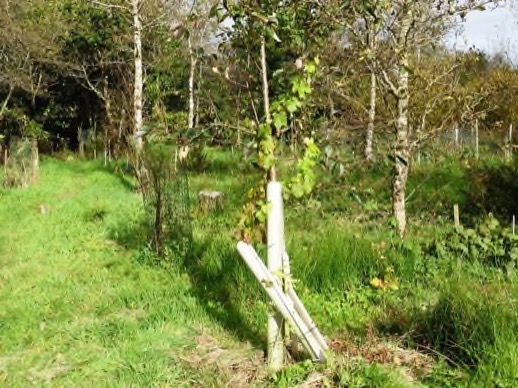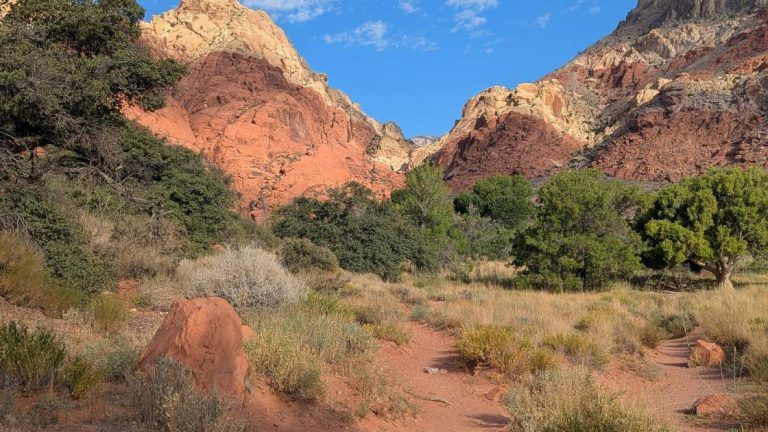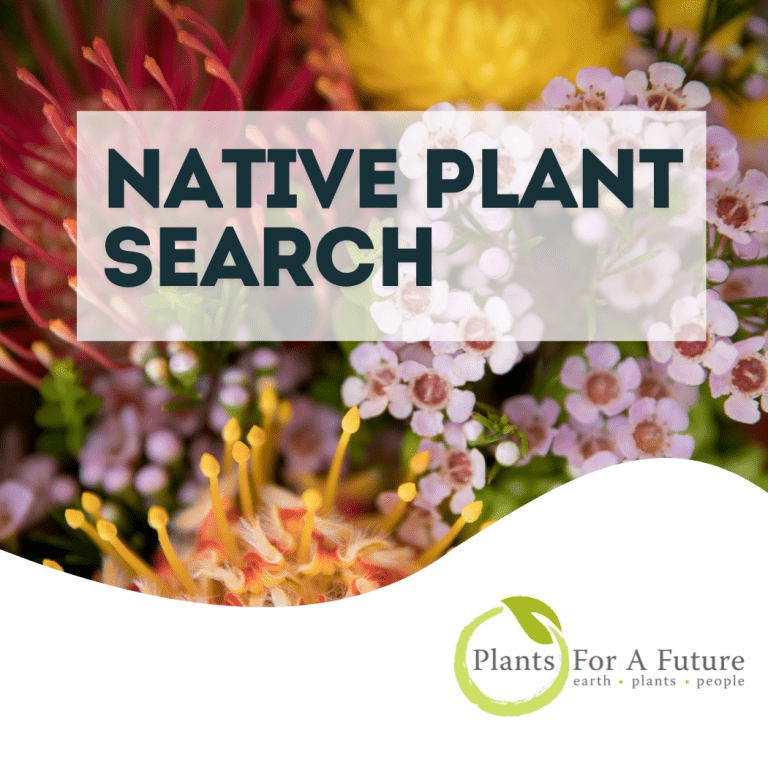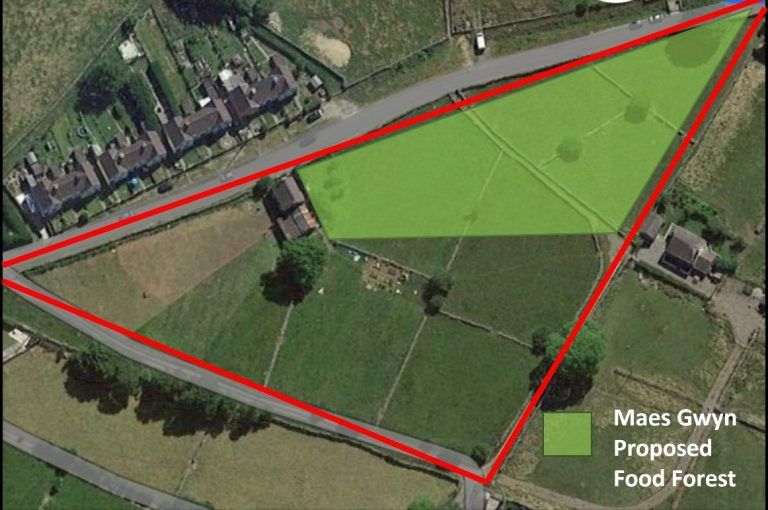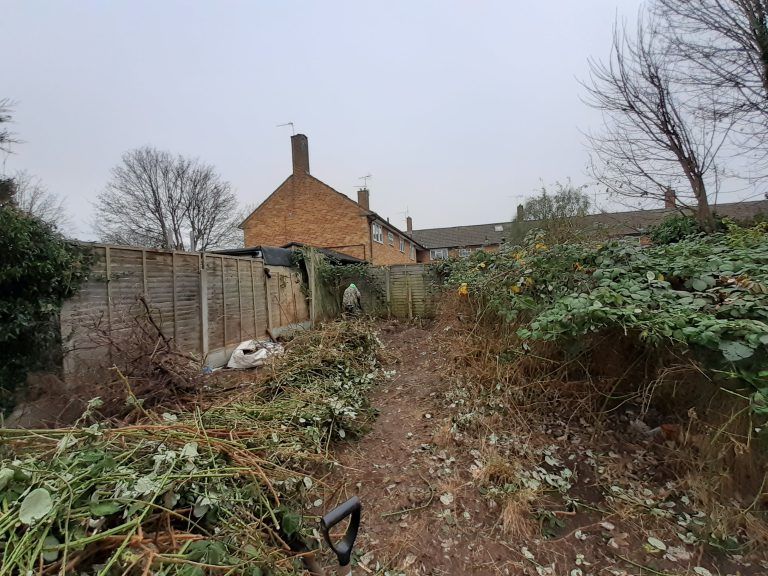In 2017 two PFAF trustees, Wendy Stayte and Chris Marsh, began a research project involving making co-operative links with people in the South West growing unusual plants, particularly perennials, in innovative ways. They began with a visit to Incredible Vegetables near Ashburton, where they made notes and took photographs, publishing the resulting photo essay on the website at http://www.pfaf.org/user/Research.aspx?id=307. Our next visit was on 26 July 2017 to the site of East Devon Forest Garden, photo essay at http://www.pfaf.org/user/Research.aspx?id=310 .
Our third visit was on 3 August to the Dartington Hall Trust Agroforestry project, photo essay at http://www.pfaf.org/user/Research.aspx?id=311 .
Our fourth visit was to Wishtree Agroforestry & Permaculture Centre in a rural setting equidistant from Bude and Okehampton, between the sea and Dartmoor (https://www.facebook.com/NorthDevonPermaculture/), where a marshy meadow and woodland site is being transformed into a food forest. Our visit to this project is the subject of the following photo essay. As with our other essays, we have provided links to plant entries in the PFAF database where this seems useful. This visit was made in early October, when many plants were beginning to shed their leaves or were dying back – we plan to return next spring to get a different perspective.
 |
| Entrance arch |
Wenderlynn and Iain Bagnall (WIB) have owned their five acre site for six years. They have worked on it full time for two years, having previously travelled from their home in Hertfordshire six or seven times a year to observe, plan, and start planting. Their main focus for the land is to follow permaculture ethics and principles, especially small-scale solutions. WIB have had no formal horticultural background but a lot of years of growing experience, and a decade of permaculture study and practice.
The previous owners had obtained a woodland grant to fund tree planting, before which cattle had been grazed on the land.
 |
| Some of the woodland on the site |
The site is situated within the Culm National Character Area. Characteristic culm species found on site include: ragged robin, angelica, marsh bedstraw and meadowsweet. Culm grassland is the habitat for the marsh fritillary, a rare endangered butterfly, but none has yet been seen here. WIB plan to introduce Devil’s Bit Scabious http://www.pfaf.org/user/Plant.aspx?LatinName=Succisa+pratensis , the food plant of the caterpillar, into a focussed area and manage it accordingly.
The site is completely off-grid and WIB have done everything with very little money; most of the materials they have used for structures have come from Freecycle or donations from friends.
WIB used hand tools to cut the mix of rushes and coarse grasses typical of culm grassland, which is normally maintained by keeping grazing animals. Most culm grassland and its habitat has been lost and Devon Wildlife Trust are working to preserve what remains. WIB respect this conservation aim, and will make sure pockets of culm are retained, but they also want to help regeneration and succession of plants. The culm includes cuckoo flower http://pfaf.org/user/Plant.aspx?LatinName=Cardamine+pratensis and marsh thistle http://www.pfaf.org/User/Plant.aspx?LatinName=Cirsium+palustre.
There are bees and butterflies in the area that has been left as a meadow.
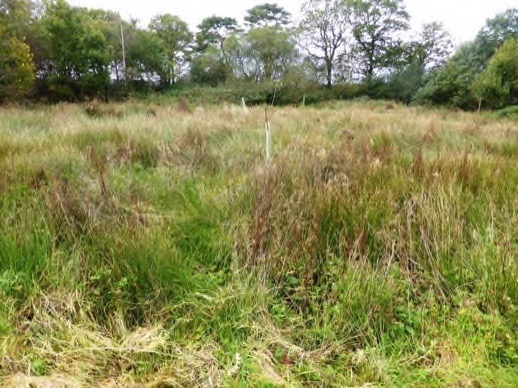 |
| Culm grassland area adjacent to the Food Forest |
A variety of tree species have been planted: alder http://www.pfaf.org/user/Plant.aspx?LatinName=Alnus+glutinosa , Sessile oak http://www.pfaf.org/user/Plant.aspx?LatinName=Quercus+petraea , red oak http://www.pfaf.org/User/Plant.aspx?LatinName=Quercus+rubra , alder buckthorn http://pfaf.org/user/Plant.aspx?LatinName=Rhamnus+frangula , silver birch http://www.pfaf.org/user/Plant.aspx?LatinName=Betula+pendula . They have also planted spindle, guelder rose, bird cherry, hawthorn, hornbeam, ash, willow (various), blackthorn, spindle, wild cherry, apple, and rowan.
WIB have planted a windbreak of oak and hazel http://pfaf.org/User/Plant.aspx?LatinName=Corylus+avellana, against winds which can gust at 50-70 mph where there is a clearing. They intend this to become a community growing space, which they aim to make more accessible. Their goal is for there to be something to eat everywhere you walk.
WIB are receiving support and training from a number of organisations with a view to North Devon Permaculture becoming a Social Enterprise. Wenderlynn teaches social permaculture to lower income families and landowning families. The aim is to interconnect land and people. She gives a free place to someone on low income with each course. WIB’s vision is that eventually the whole site will be food forest, and already people love to meander around. A limiting factor at present for inviting visitors, including less mobile people, is the muddy area just in from the entrance. WIB are collecting stone from the site to gradually build that up. They may have a fundraising effort for money to pay for hardcore and surfacing.
WIB have learned from things that just happened, like alder regenerating after coppicing. They have also used alder branches as fence posts and these have sprouted. They now deliberately use this tactic to create long-lasting, N-fixing fence posts.
On being asked if there is an evolving plan, we were told that they have a site map which was derived from a loose plan drawn up two years ago. Observation is key to the plan evolving. WIB are still learning from observation. They use what Ben Falk calls ‘Active Observation’, which suits their design style and way of doing things. The water and clay on the site is a limiting factor plus a benefit. The site doesn’t dry out. Crucially, this means that although they have to contend with wet soil, they also rarely if ever have to water anything outdoors. After three weeks without rain, you could sit on the grass and still get wet. Over three months with only three days without rain they have learnt where the water sits longest. Because the site is mainly heavy clay water sticks on the surface. WIB planned to create ponds; five ponds are already in place, several more are planned including a large ‘main’ pond.
 |
| One of the existing ponds |
The principle is to keep moving the surface water and then store it, with its accumulated nutrients, to cycle back into the soil. WIB would use the system to catch and store water and for aquaculture. They have dug ditches which will be connected. There is a seasonal stream.
Permaculture-style Guilds
We were shown around part of the site with many examples of close companion-planting, on mounds with supports and protection. The remainder of this essay contains several lists of the plants making up these guilds and their properties. Some of these are at an early stage of establishment and we look forward to returning next year to see how they are getting on.
Apple http://www.pfaf.org/user/plant.aspx?LatinName=Malus+domestica , brandt grape and vetch http://pfaf.org/user/Plant.aspx?LatinName=Vicia+sativa . Vetch is N-fixing.
Apple, grape and vetch
Apple, chardonnay grape and broom http://www.pfaf.org/user/plant.aspx?latinname=Cytisus+scoparius . Broom is N-fixing and has edible flower buds tasting a bit like pea and capers.
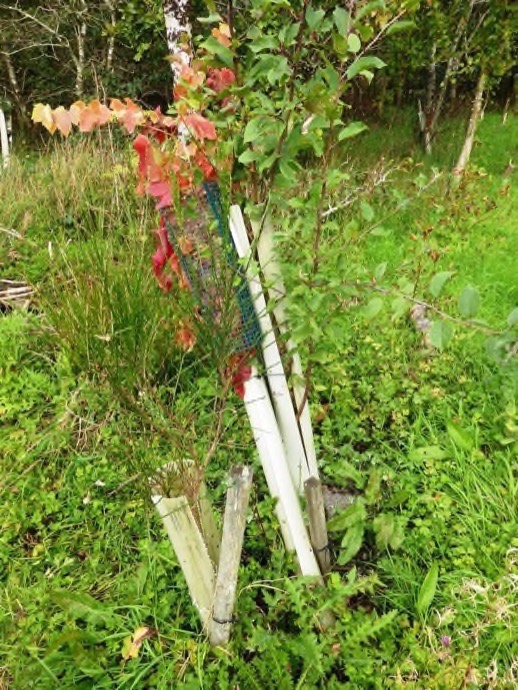 |
| Apple, grape and broom |
Autumn olive is N-fixing, from the elaeagnus family, with edible berries. WIB have been propagating this from seeds and cuttings.
Applemint http://www.pfaf.org/user/Plant.aspx?LatinName=Mentha+suaveolens is a ground cover plant and is edible. Black/chocolate mint http://pfaf.org/user/Plant.aspx?LatinName=Mentha+x+piperita+vulgaris with wild strawberries controls the grass. Rush mulch is much in use.
 |
| Rush mulch on top of cardboard covering an area that has been set aside for a permaculture demonstration area to support educational and community support activities |
The plan includes areas of different scales to demonstrate to visitors. Visiting children have given names to some of the areas, such as ‘Gaia’s Nest’, an oak tree that a Japanese girl who visited climbed into and had all sorts of adventures! Children play an important part in naming areas of the site, and WIB will continue to respond to their imagination and enthusiasm in this way.
WIB are involved in a pre-school project. According to the curriculum, the school has to meet the seven areas of learning, both indoors and outdoors. WIB’s project is aimed at helping the school to meet the outdoor criteria. The children have responded very well to their interactions with the plants, particularly with tactile, hands-on activities.
 |
| Allotment area of perennial plants |
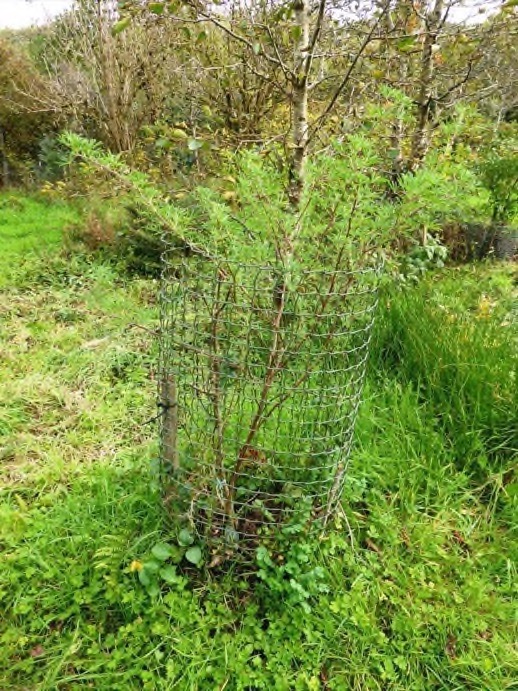 |
| Tree lupin and salad burnet |
WIB are keen to experiment with different plants they could try in guild combinations. Another guild in the food forest area is the tree lupin guild: http://www.pfaf.org/user/plant.aspx?latinname=Lupinus+arboreus – grown from seed last April, planted raised up on a mound, with salad burnet http://www.pfaf.org/user/plant.aspx?LatinName=Sanguisorba+minor and periwinkle http://www.pfaf.org/user/plant.aspx?latinname=Vinca+minor . This guild also contains groundcover raspberry and cosmos.
The alder coppice has a 20 year cycle. They are N-fixing canopy trees. In a natural situation alder reproduces by dropping seeds into water. WIB have successfully propagated alder by floating seeds, and some of this year’s seedlings are already 3-4 feet high.
 |
| Sedum, water pepper and wild strawberry |
Sedum http://pfaf.org/user/Plant.aspx?LatinName=Sedum+telephium with pink flowers is a salad plant. Water pepper http://www.pfaf.org/user/Plant.aspx?LatinName=Polygonum+hydropiper . The tree guard contains a young Bladder Senna (N-fixing support shrub). Also in this guild but out of the shot are daylilies.
WIB have one Szechuan pepper tree which they thought had died, but this summer, it actually put out some fresh growth from the base, so they are keeping their fingers crossed.
Plum http://www.pfaf.org/user/plant.aspx?LatinName=Prunus+domestica and vetch. WIB thought they were growing hardy kiwis but they actually were a mystery luck dip of legumes! Alder and wild hop http://www.pfaf.org/user/Plant.aspx?LatinName=Humulus+lupulus .
WIB tried mulberry but it died – but it’s all a learning experience. They will keep trying with mulberry on higher mounds to give them even more lift out of the wet, especially as they are a key part of the guild discussed next.
Black walnut http://pfaf.org/User/Plant.aspx?LatinName=Juglans+nigra . This contains a chemical called juglone, a growth inhibitor, which some plants especially mulberry are supposed to be resistant to, but which they hope will help control bamboos.
We were shown fencing against deer and rabbits. The fencing material is mostly old netting and chicken wire that they have acquired from Freecycle, donations etc. It does not totally enclose the food forest, but goes along the main deer runs, meaning the deer have to go out of their way to access the goodies on the other side of the fence. The fencing has helped towards having a balanced ecosystem. From time to time, they see an increase in rabbit damage, and it seems to follow that, soon afterwards, they find crime scenes of fur and blood. Whether that is buzzards, owls etc. they are not sure, as they have those on site, as well as foxes, weasels, stoats etc. This is another opportunity for learning, as they are beginning to look into tracking and how to determine which of their predators is doing their pest control for them.
 |
| Protective fencing and bamboo, with Chris, Iain, and visiting cat |
There is a bird cherry http://www.pfaf.org/user/Plant.aspx?LatinName=Prunus+padus hedge which sprouted. Through experimentation and observation, WIB have found that this works with willow (of course), but also: alder, rowan, bird cherry, elder, poplar, and possibly more.
The bird cherry ‘hedge’ came about through creating a low hugel-y berm around the main food forest area; WIB were digging out a pond, and put the soil on piles of bird cherry brash. Accidentally and fortuitously, what resulted was a very nice bird-cherry hedgeline. They have since replicated this deliberately to create hedges elsewhere on site, so very much in keeping with permaculture principles such as Observe & Interact, Least Work for Greatest Effect, and Work With Nature. Bird cherry is the first plant to leaf out, and flowers early attracting hover flies, and is a good fuel wood – a ‘system plant’.
 |
| Bird Cherry hedge. |
Rowan http://www.pfaf.org/user/Plant.aspx?LatinName=sorbus+aucuparia was a branch stuck in the ground that sprouted.
Ground cover raspberry http://www.pfaf.org/user/plant.aspx?latinname=rubus+nepalensis , alder and grape vine.
Bush clover http://www.pfaf.org/user/Plant.aspx?LatinName=Lespedeza+bicolor is N-fixing and was grown from seed last year.
Autumn olive http://pfaf.org/User/Plant.aspx?LatinName=Elaeagnus+umbellata has tiny red berries, and – especially in this mild climate – loses its leaves around December, comes back into leaf around February, so it has some leaves for most of the year. It is edible and good for wildlife, almost evergreen, used for ‘chop and drop’ and is N-fixing.
Perennial/Vietnamese coriander is considered not hardy in some parts of the country, but here it has gone through two winters and is thriving and spreading. It is also self-seeding, so seems to be very happy here, as ground cover (if there is too much it goes to ‘chop and drop’) with applemint growing through it.
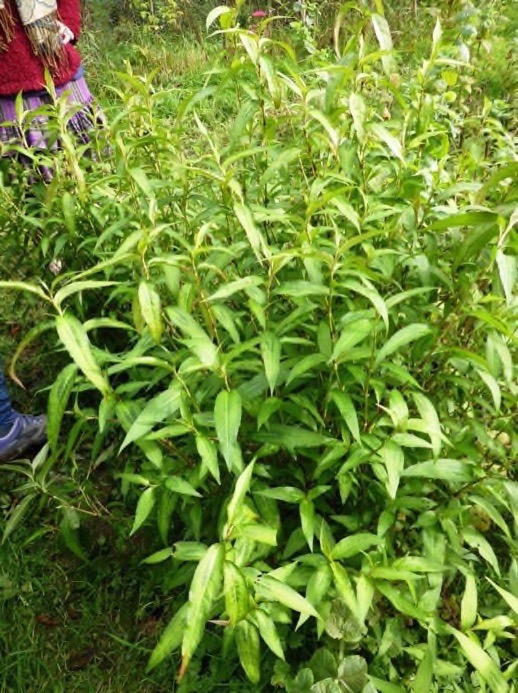 |
| Perennial coriander |
Perennial coriander was grown from a single small cutting, and has spread fabulously, gone through a cold winter, and has come back again and is thriving.
Bladder senna http://pfaf.org/User/Plant.aspx?LatinName=Colutea+arborescens is N-fixing.
 |
| Hornbeam |
Hornbeam http://pfaf.org/User/Plant.aspx?LatinName=Carpinus+betulus .
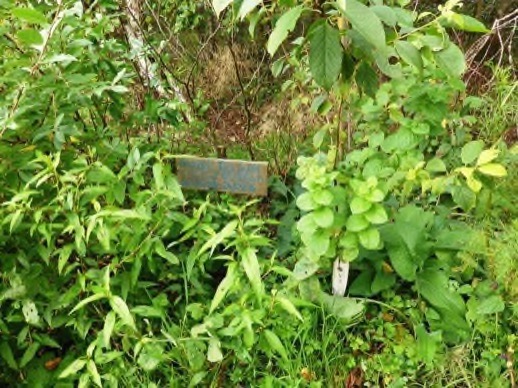 |
| Snowbell guild |
Snowbell trees http://www.pfaf.org/user/Plant.aspx?LatinName=Styrax+japonica have cucumber-like pods. In September 2016, WIB planted a Snowbell guild to mark the death of Permaculture pioneer Bill Mollison.
Blackcurrants http://www.pfaf.org/user/Plant.aspx?LatinName=Ribes+nigrum , salad burnet, self heal http://www.pfaf.org/user/plant.aspx?LatinName=Prunella+vulgaris which is naturally occurring, with edible flowers, to make tea and with medicinal uses.
Also in this guild are apple mint, comfrey, strawberries, surrounded by N-fixers: autumn olive and a canopy of mature alders.
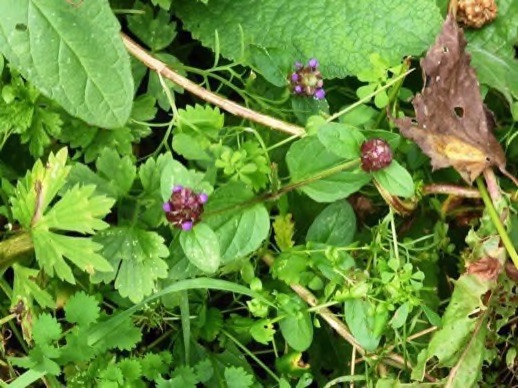 |
| Self heal |
Cosmos http://www.pfaf.org/user/Plant.aspx?LatinName=Cosmos+bipinnatus has edible flowers, and bees and butterflies love it.
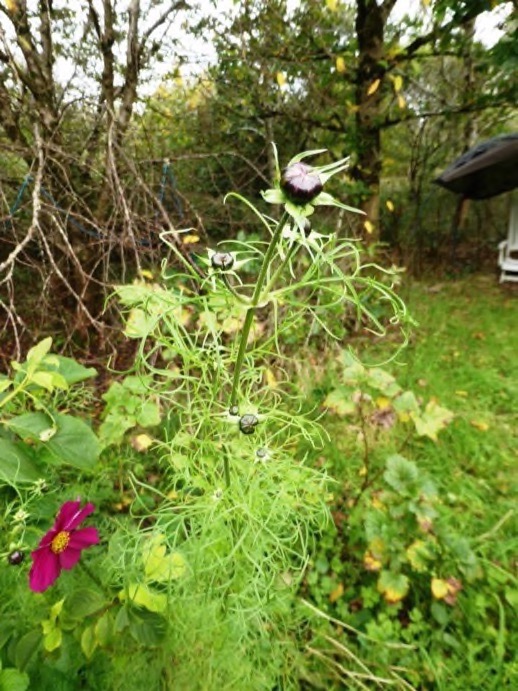 |
| Cosmos |
WIB dug a pond, with the help of WOOFers, taking the spoil to the berm/hugel mound. They left two islands. It will need much deeper water, and they may remove one of the islands. The pond has much diversity of wildlife, including greater diving beetle, which links to the bird cherry hedge, as noted above.
 |
| Islands in the wildlife pond |
Sweet flag http://pfaf.org/User/Plant.aspx?LatinName=Acorus+calamus has edible roots.
Birdsfoot trefoil http://pfaf.org/user/Plant.aspx?LatinName=Lotus+corniculatus occurs naturally on site.
Siberian currants http://pfaf.org/user/Plant.aspx?LatinName=Ribes+diacanthum are still tiny, grown direct in the ground from cuttings. WIB were given by another permaculture project in 2016; they seem to be doing well.
Blackcurrants on the site are most prolific, reliable and consistent crop so far, despite being in for only a couple of years.
New Zealand flax http://www.pfaf.org/user/Plant.aspx?LatinName=Phormium+tenax
 |
| New Zealand flax |
WIB have made a Comfrey http://www.pfaf.org/user/Plant.aspx?LatinName=Symphytum+officinale tractor in a trough with 20 holes in the bottom for the roots to go through. Once established this is lifted and cut, leaving the roots which will regrow, then the tractor with the tops is moved on and grows more roots. Magic! Comfrey is high in potassium, and used for ‘chop and drop’ 3-4 time per year.
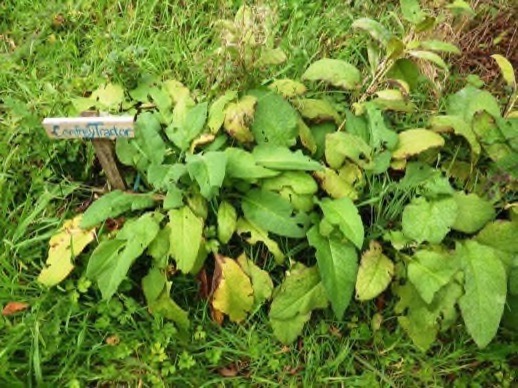 |
| Comfrey tractor |
The comfrey tractor is an experiment that WIB are excited to continue. It reminds them of the timescale of natural systems, as they basically just had to set it up (in March) and then wait a year. It seems to have rooted well into the ground, as it is immovable now, so they will see next Spring how it goes.
Almond http://www.pfaf.org/user/plant.aspx?LatinName=Prunus+dulcis has flowered. It is included in a guild with goumi http://pfaf.org/User/Plant.aspx?LatinName=Elaeagnus+multiflora and groundcover raspberry
Yarrow http://pfaf.org/User/Plant.aspx?LatinName=Achillea+millefolium has white flowers, loganberries http://pfaf.org/User/Plant.aspx?LatinName=Rubus+loganobaccus .
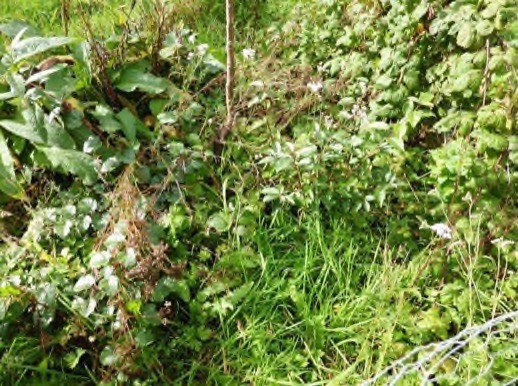 |
| Almond guild |
The almond guild includes Goumi for N-fixing, comfrey and yarrow for nutrient accumulation, insects etc. and groundcover raspberry.
WIB aim to have perpetual successions, e.g. wire netting doing a useful job now will be moved and reused at the boundary. They use molehills and leaf-mould to make potting compost. However, for plants to be sold they have to use bought compost to avoid passing on weed seeds.
 |
| Rowan, alder, elder and hazel laid as a hedge |
Maple (in the centre of the picture above) http://pfaf.org/User/Plant.aspx?LatinName=Acer+palmatum. WIB wouldn’t have chosen to plant the maple there if they were starting with a blank canvas, but as they are working among existing trees, they chose to keep the maple for its aesthetic value as much as anything else.
Turkish rhubarb http://pfaf.org/user/Plant.aspx?LatinName=Rheum+palmatum has done better than ‘standard’ rhubarb when planted directly into the soil here. Standard rhubarb does very well too, but has to be mound-planted to lift it above excess wet, so the Turkish wins out for energy return on energy invested.
WIB are growing apple saplings from seed for grafting – a skill they will be learning.
A big bramble patch was retained to act as a wind-break to protect sea buckthorn – but the ground is too wet. They are going to dig up the sea buckthorns, put in a 2 foot high berm, and replant them on top, to give them some lift above the wet soil.
The polytunnel was only built earlier this year. Amongst the plants in it are spelt, cosmos, calendula and amaranths. Hopi red amaranth is attractive but hasn’t done brilliantly. Mixed leaf has done very well, producing a lot of leaves and growing happily outside through all weathers. Some mixed grain have done amazingly well, and a lot of grain has been harvested from them this year. The following picture shows some nine-star perennial broccoli seedlings, and the more lime green ones to the top left are tree cabbages.
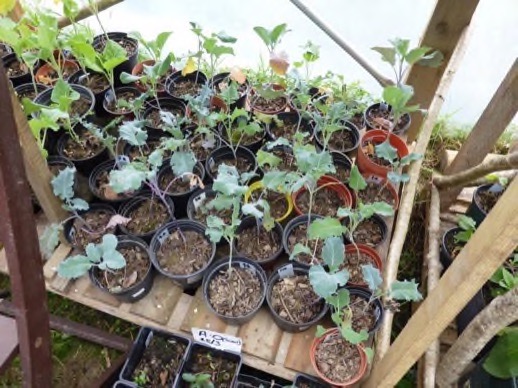 |
| Nine star perennial broccoli and tree cabbage |
More seedlings in the polytunnel.
 |
 |
Plants in the first picture: Pokeberry – edible when cooked, also for ink; Mount Etna Broom – nitrogen fixer; Tree Lupin – nitrogen fixer; Echinacea – medicinal.
And in the second picture: Bladder Senna, Siberian Pea Tree, Tree Lupin and Bush Clover, all nitrogen-fixing support trees. These pots are seeded with clovers, plantains, salad burnet etc. as well as the trees, so that when they go in the ground, they are also introducing the ground cover plants as well. These grow well together, and continue as a community when planted out.
WIB are experimenting in growing spelt http://pfaf.org/User/Plant.aspx?LatinName=Triticum+aestivum+spelta , and planning a bigger patch next year. Through the Permaculture Association they are a Learning And Network Demonstration (LAND) site, currently with Learner status, hoping to get to full LAND status next year if possible, (https://northdevonpermaculture.com/land/ ). They are currently writing up this research project.
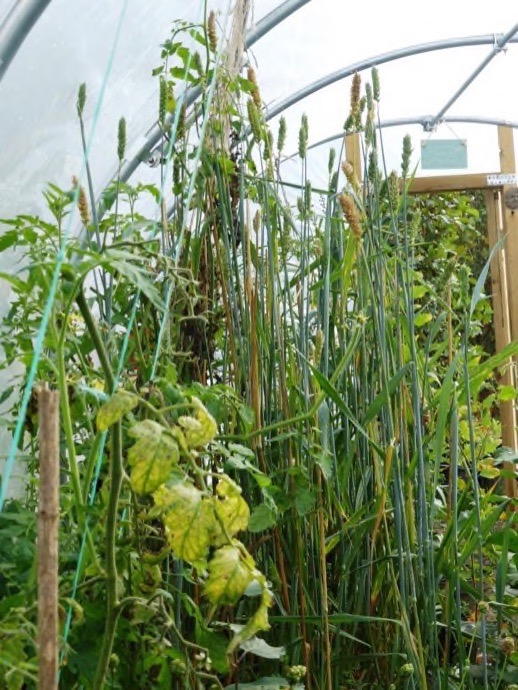
Spelt in the polytunnel |
A key point with the small trial this year was that WIB grew a similar sized numbers of plants outside as well as in the polytunnel. The polytunnel was more as a backup as they can’t contemplate growing grains on any scale in a tunnel long-term. This was an experiment, but also important as they only had a few seeds that were a few years old, grown permaculturally on another project. So the main priority with the spelt was to get enough home-grown seed for scaling up into a more substantial trial next year. What was really encouraging was that the plants outdoors have done as well as, if not better than, those in the tunnel, despite quite a wet summer.
Returning Next Spring!
In the photo-essay above we have made use of notes and observations from a short visit on 4 October 2017. We could not study the whole site in detail but have concentrated on the ‘edible forest’ area and its permaculture-style guilds. As mentioned above, many of the plantings are experimental and it will be interesting to come back in spring and/or summer to see how they have got on, and we can also have a better look at the rest of the site. Also, PFAF trustee Wendy Stayte, who has been part of our other Devon studies, was away travelling to India in October, and she will be eager to see the Wishtree site.
 |


